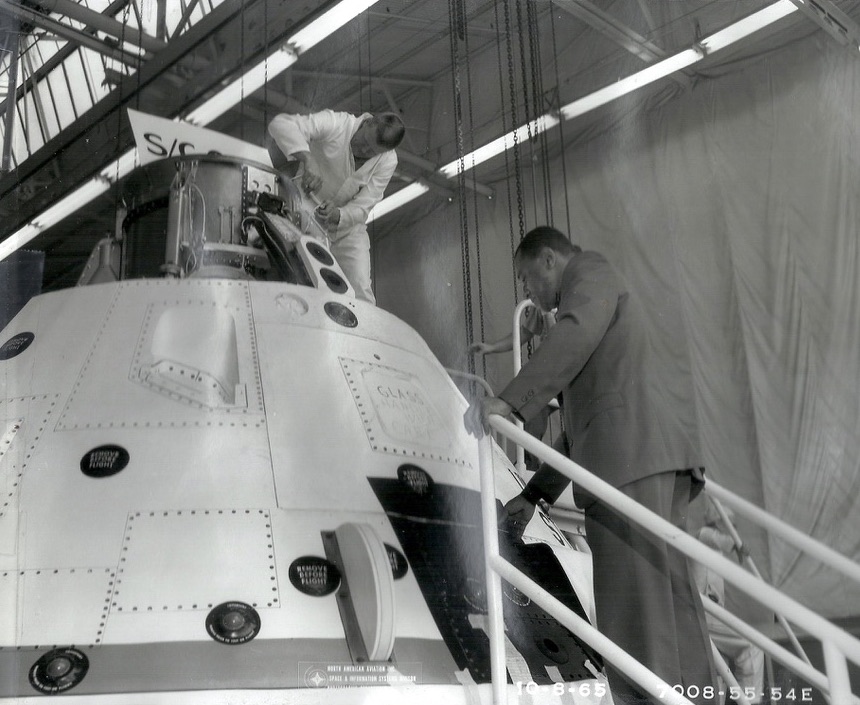The Museum will be closed January 12th - January 16th in preparation for our new Special Exhibition Ripley's Believe It or Not!. Museum reopens Saturday January 17th. New Exhibit opens January 31st!
Casson was responsible for the test and checkout of every manned spacecraft during the Apollo program, as well as conducting the mission final “dress rehearsal” with the assigned astronauts on board the spaceship, operating the controls, all of which was monitored and responded to from control rooms like those at Houston and the Cape. He managed all the technicians, the test procedure engineers, four control rooms, tank farm fluid & gas facilities, the systems engineers, the Senior Test Project Engineering Managers, all clerical and operations support personnel, and the Apollo Post Recovery operation. The latter was a team of engineers and technicians who were at the splashdown area for all Apollo vehicles returning from space, saving the systems, and taking steps to prevent hostile contamination from the moon's surface.

Aerial view of the Downey Plant.
During his long career, Casson received many awards, citations, plaques, special honors, and letters of appreciation for his accomplishments. He was nominated three times for “Outstanding Young Man in America.” He was presented the Gold Titan Award for TITAN I, and later for TITAN II, was one of only seven engineers at the time to have received two Gold Titan Awards. For his “Above & Beyond” contributions to the Apollo program, Casson was awarded the most coveted “Silver Snoopy” by the Apollo astronauts. The Charles Shultz comic character Snoopy was the official mascot of the Apollo program. He also received certificates, awards, and special recognition for his ability to organize large groups and for his exceptional ability as an effective executive manager.

Apollo Service Module leaving the Building 290 at the Downey facility airlock to be transported for delivery to the Cape.
Many, if not most, think that the Apollo spacecraft was “born” in either Cape Kennedy, Florida, or at the Space Center in Houston, Texas, but this is not the case. Every Apollo spacecraft, manned or unmanned, was conceived, designed, fabricated, manufactured, and assembled, then taken through its entire test, checkout, and mission dress rehearsal in Southern California. This took place at Downey, on Lakewood Boulevard, by NASA's prime contractor, North American Aviation (later North American Rockwell), at the massive Space Division complex taken over by NASA for Apollo. It consisted of several buildings and several hundred acres of land; it was a “city within a city.”

Mr. Casson "Checking Out" an Apollo spacecraft.
NASA and North American Aviation assigned total responsibility for the Apollo Spacecraft Checkout group, which included engineering, the entire budget, and administration for this organization, to Norman Howard Casson. This “Apollo Spacecraft Checkout Group” functioned like a well-organized unit in a factory-like manner to get all Apollo spacecraft certified for their missions into the deep void of space. The Apollo Spacecraft Checkout team maintained program schedule dictates, had no major injuries to personnel, was praised by NASA for shipping spacecraft that were ready to launch, and ensured astronauts were ready for their flights because they had already been through much of the mission on the ground at the Apollo Spacecraft Checkout facility, in Downey.

Maintenance protective covering is being installed onto the Apollo Command Module in Building 290.
A complete engineering test team was assigned to each of the four tall checkout stations located at the Downey complex in Building 290, where four Apollo spacecraft were checked out simultaneously. Each engineering test team consisted of system engineers, quality control engineers, safety engineers, test conductor engineers, test technicians, test pilots, test procedure engineers, automatic data processing engineers, and certified engineers to handle supercooled cryogenics and extremely toxic fuels and oxidizers. The test team organization also had its own clerical staff and four Control and Information Centers (one for each team), with real-time status plotters and supervision for each test team. This is also where each team (including the astronauts) held their pre-test briefings and post-test review meetings.

Loading Apollo Command Module onto the Pregnant Guppy. Spacecraft has completed all of it’s mission testing, certified, and signed off by Norm, soon to be in the air on it’s way to the cape.
The astronauts assigned to each spacecraft were pre-certified for their missions only after they had completed several months of training at the test facility by operating the onboard spacecraft controls during each test and checkout phase. Each test team was managed by a top-level engineering manager, called the "Senior Test Project Engineering Manager." This entire engineering test team, including each Senior Test Project Engineering Manager, all of the engineers, test conductors, technicians, clerical people, and procedure writers, was organized within one huge organization for the engineering test and checkout and dress rehearsal of each of those manned spacecraft. This organization was known throughout the world of Apollo as “Apollo Spacecraft Checkout,” and Norman Casson was responsible for the entire organization.
2001 Pan American Plaza, San Diego, CA
Phone: 619.234.8291
Información En Español
Contact Us
We would like to thank all our sponsors who help us make a difference. Click here to view all who help us.

The San Diego Air & Space Museum is a 501(c)(3) non-profit organization. Federal Tax ID Number 95-2253027.
